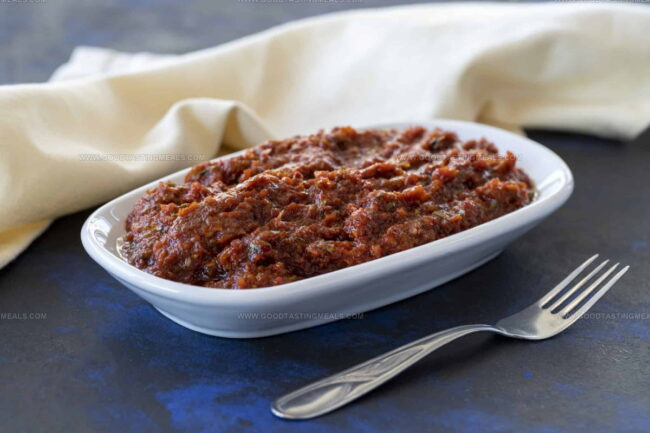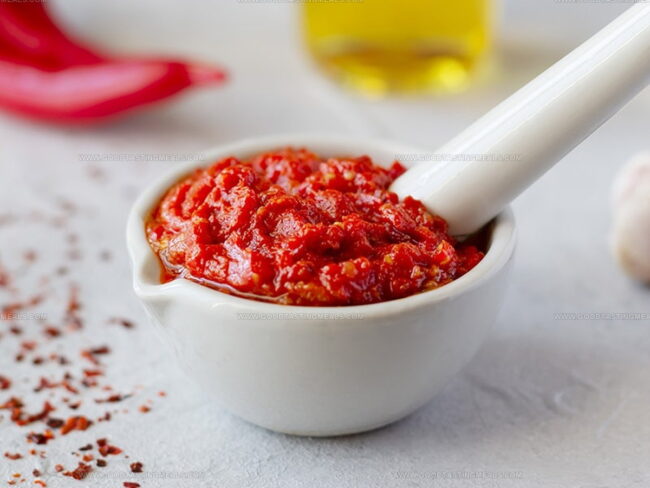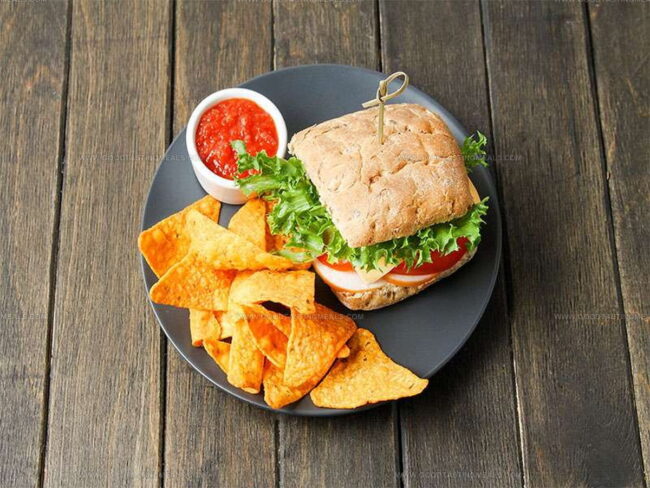What Does Harissa Taste Like? A Spicy Adventure for Your Tastebuds
Harissa, a fiery North African condiment, has been causing quite a stir in culinary circles lately.
Passionate food lovers can't stop talking about this vibrant red sauce that transforms ordinary dishes into extraordinary experiences.
Bold and complex, this spicy blend carries deep cultural roots from Tunisia and Morocco.
Home cooks and professional chefs alike have been incorporating harissa into their recipes with increasing enthusiasm.
The mysterious combination of ingredients creates a flavor profile that leaves people curious and craving more.
Serious food enthusiasts wonder about its unique characteristics and potential to elevate their cooking.
Every bite promises an adventure that tantalizes taste buds and challenges traditional flavor expectations.
Are you ready to unravel the delicious secrets of this remarkable condiment?
What Is Harissa?
Harissa is a bold, spicy chili paste that’s a staple in North African kitchens.
Its bright red color comes from hot chiles, blended with garlic, coriander, caraway, cumin, and olive oil for a deep, rich taste.
Harissa adds sharp heat and a hint of sweetness to soups, stews, sauces, or as a topping for salads and roasted veggies like eggplant and peppers.
Most people believe Tunisia made harissa popular, and today, you can easily find it in grocery stores, usually near the dried spices.
Harissa’s fiery flavor and aroma make it a favorite for cooks who want to add a little kick and character to their meals.
Harissa Nutrition Details
Harissa stems from Tunisia as a fiery sauce with deep roots.
Its name harsa signals heat, fitting perfectly with chili peppers being a key ingredient.
Cooks use this sauce as a topping or condiment for dishes like falafel, shawarma, and dumplings.
Chili peppers contain capsaicinoids that spark health benefits.
Research shows these compounds can lower cholesterol and reduce inflammation for some arthritis patients.
Harissa packs nutrients from fresh vegetables, potentially replacing vitamin supplements.
Magnesium within harissa supports blood pressure control and muscle function.
Its health perks extend beyond basic nutrition.
Vitamin C and beta carotene found in this sauce might decrease heart disease risks.
Lemon juice gives harissa its signature zest, so fresh preparation matters for maintaining flavor.
Herbs play a crucial role in creating harissa's complex profile.
Cilantro, mint, parsley, cardamom, and paprika blend together to craft an earthy and rich spice mixture that makes this sauce special.
How Harissa Tastes
Harissa has a bold, spicy flavor with layers of taste that make it more than just hot sauce.
Each spoonful brings peppery heat, smoky undertones, and a mix of rich spices like coriander, cumin, garlic, and salt.
You’ll notice strong garlic and a touch of citrus that make the flavors pop, with some versions leaning more smoky or tangy depending on the peppers used.
The deep red color and intense aroma let you know harissa is full of character, while the roasted pepper and tomato notes add extra depth.
Spice levels can be mild or fiery, depending on the recipe, so trying different brands helps you find what you like best.
Capsaicin in harissa not only gives it heat but may help boost metabolism and curb hunger, making it a flavorful pick for health-conscious eaters.
Harissa Paste And Powder Compared
Harissa powder might catch your eye when searching for harissa paste.
Key differences exist between these two products.
Paste contains liquid elements like oil or water, sometimes mixed together.
Powder represents a dry version of peppers and spices ground into a fine mix.
Cooking with harissa powder works just like using any standard dried spice blend.
Cooks can quickly create a homemade harissa paste by blending the powder with oil and water.
This simple technique allows kitchen enthusiasts to transform the dry mix into a spreadable, flavorful condiment matching traditional harissa paste consistency.
How to Make Harissa Sauce
Harissa brings spicy warmth from North African kitchens, mixing chili peppers, garlic, cumin, and coriander into a bold paste. Chefs in Tunisia and Morocco craft this seasoning with classic spices like caraway seeds, sometimes adding roasted red bell peppers for extra depth.
Making harissa happens through simple steps:
Is Every Harissa Spicy?
Not every harissa is super spicy, how hot it is depends on the type of chili peppers used and the recipe.
Some harissa pastes are made with mild peppers, so they taste smoky and rich but not too hot.
Others use hotter chilies for a real kick.
You might also find store-bought harissa labeled as mild or spicy, so you can pick what suits your taste.
If you’re making harissa at home, you can control the spice level by choosing milder peppers or removing the seeds.
So, while harissa is usually known for its heat, there are plenty of milder versions out there too.
Ways to Use Harissa in Cooking
Harissa is a versatile ingredient that brings bold heat and rich flavor to many dishes.
Here are some easy and tasty ways to use it in your cooking:
Difference Between Harissa and Sriracha
Harissa and sriracha are both spicy condiments, but they come from different parts of the world and have unique flavors.
Harissa is a North African chili paste made with roasted red peppers, hot chili peppers, garlic, olive oil, and spices like cumin, coriander, and caraway.
It’s thick, earthy, and has a smoky, deep flavor.
Sriracha, on the other hand, is a bright red, smooth hot sauce from Thailand made mainly with chili peppers, vinegar, garlic, sugar, and salt.
It’s tangy, sweet, and slightly garlicky with a thinner texture.
Harissa is usually used as a paste or marinade in North African and Middle Eastern dishes, while sriracha is often squeezed on top of foods like noodles, eggs, or sandwiches for extra heat and flavor.
In short, harissa has a rich, smoky taste and thicker texture, while sriracha is tangier, sweeter, and more pourable.
Can You Swap Paprika for Harissa?
You can use paprika instead of harissa in some recipes, but they are not the same and will give different flavors.
Paprika is a mild, sweet, or smoky red spice made from dried peppers, and it’s much gentler in taste.
Harissa is a bold, spicy chili paste with garlic and spices, so it’s much hotter and richer.
If you swap paprika for harissa, you’ll miss out on the heat and complex taste that harissa brings.
To make a closer match, you can mix paprika with a little cayenne pepper, garlic, and a touch of oil, but it still won’t be exactly like harissa.
In simple recipes, swapping works if you just want color or a mild flavor, but if the recipe relies on harissa’s unique kick, the swap won’t taste the same.
Is Harissa Like Chili Paste?
Harissa is a type of chili paste, but it has its own special flavor and ingredients.
Most basic chili pastes are made with just chili peppers and maybe a little salt or oil.
Harissa, on the other hand, blends chili peppers with garlic, olive oil, and spices like cumin, coriander, and caraway, making it richer and more complex.
It’s thicker, a bit smoky, and brings both heat and lots of flavor, while regular chili paste is usually just spicy and straightforward.
So, harissa is like chili paste, but with extra layers of taste that make it stand out.
Best Way to Store Harissa
The best way to keep harissa fresh is to store it in an airtight container in the refrigerator.
Make sure the lid is tightly closed to keep air out and stop it from drying out.
If you want your harissa to last even longer, you can add a thin layer of olive oil on top after each use, this helps seal in the flavor and moisture.
Always use a clean spoon when scooping out harissa to avoid adding bacteria.
Stored this way, harissa can stay good for up to a month, but always check for any changes in smell or color just in case.



